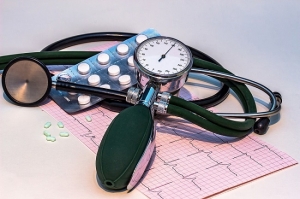
Source: pixabay.com
Keeping tabs on your health is the best investment you can ever make in yourself and your family. Many people only visit the hospital when something has already gone wrong, and that should never be the case. Some diseases, like hypertension, have to be monitored at all times.
High blood pressure can negatively impact your life as it can limit many of the activities you are used to. It also opens up your body to other complications. BP monitors are the best solutions that can tackle hypertension head-on. Blood pressure monitor manufacturers have made great strides in meeting the increasing demand for home blood pressure kits.
People can now check their blood pressure as many times as they want from the comfort of their homes. Knowing where you stand healthwise helps you in properly planning your life.
What Is a Blood Pressure Monitor?

Source: https://www.raycome.com
A blood pressure monitor is a device that is used to measure blood pressure. To better understand what a BP monitor is, you have to know what blood pressure is and why it must be kept in check.
Blood pressure is the force that is exerted on the walls of the blood vessels by the blood as it flows through them as the heart pumps. The pressure exerted by the blood comes in two forms: Systolic and Diastolic.
Systolic is the blood pressure that is created when the heart contracts to pump blood around the body, while diastolic blood pressure is the one exerted between the heartbeats as the heart relaxes. This alternating between these two is what is ultimately referred to as the blood pressure. So why is it necessary to measure blood pressure?
Higher blood pressure is dangerous for your body. It exerts a strain on the heart, the blood vessels, and this can interfere with the proper way that blood gets distributed around your body. If all these organs are strained, you stand a risk of being hit with a myriad of health problems like heart attacks, dementia, kidney diseases, or a stroke.
What makes high blood pressure truly dangerous is that it is hard to detect without the use of a blood pressure monitor. Most people discover they have hypertension when they are on their hospital beds after suffering a stroke. This is the reason why having at least one in your home is very important.
How does a Sphygmomanometer Work?
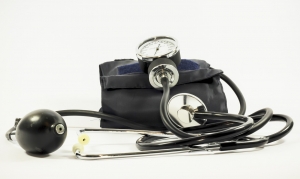
Source: pixabay.com
As earlier stated, a Sphygmomanometer measures the blood pressure. Before we explore how they work, you should get familiar with the different parts that make up a blood pressure monitor. They include the following:
Bladder

Source: pinterest.com
This is the inflatable rubber bag that fits around the arm for compression. It is the part inside the cuff that gets filled with air. They come in different sizes and specific parameters. Each bladder has a check valve located at their ends that prevents the air from escaping or the entry of dust. Most are made from spin cast PVC.
Manometer

Source: pinterest.com
This is the part of the device that does the actual measurements of air pressure and is denoted by mmHg. In Aneroid BP devices, the manometer looks like a watch that has an indicator dial with number values written in a circle. As you pump the air into the cuff, the manometer is the part you observe to know if you have reached the required air pressure needed for the test.
The Cuff
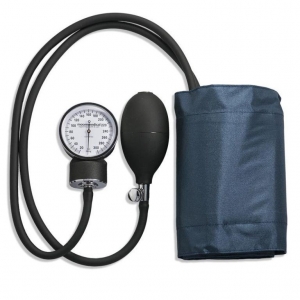
Source: pinterest.com
This is the part that is wrapped around the arm to get readings. It is the casing that houses the bladder allowing it to inflate and deflate as the air is pumped in and out during measurements. Being the most crucial part, the cuff has to be appropriately designed to fit the arm in the right position; otherwise, the data it collects will not be accurate.
The Bulb
A bulb-shaped contraption made of rubber that is attached to the bladder through a rubber pipe. The bulb fruits inside the palm, and it is used to pump air into the bladder manually.
The Valve
A deflation metal pin that is used to control the cuff. Tiny as it is, it is one of the major components that play a vital role in attaining accurate readings. Most valves are made out of brass and are plated with either nickel or chrome.
The procedures the precede the measuring of the blood pressure follows these steps:
- The cuff is wrapped around the upper part of the arm at a position that is directly opposite to the location of the heart. The cuff should be able to fit the arm well since it needs to apply pressure all around for it to be able to measure any readings. The lower edge of the cuff should be about one inch above the antecubital fossa.
- Once the cuff is in place, the stethoscope bell is lightly pressed against the brachial artery that is located just below the cuff’s edge. Locating it will be hard if you fail to position the cuff as instructed.
- The next step involves the rapid inflation of the cuff using the rubber bell for manual BP monitor and or keying in the value for a digital monitor. The cuff should be inflated to about 180mmHg. After that is attained, the air is then released from the cuff at a constant rate of about 3mm/sec.
- While the air is being released, the doctor listens intently to the stethoscope while observing the mercury gauge dial. The first sound that the Sphygmomanometer produces is called the Korotkoff. It is a knock-like sound that indicates the systolic blood pressure has been recorded. The moment the Korotkoff disappears; that is an indication that the diastolic pressure reading has been taken.
- The same procedure is repeated for the next arm, and the values are compared. For a better result, the process can be repeated two to three times in one sitting with a few minutes separating the measurements. If the blood pressure reading is in the region of 180/120mmHg and above, then immediate medical attention is needed.
How to Use a Blood Pressure Monitor

Source:
When it comes to homedics blood pressure monitors, the operation is much simpler than a manual one. In fact, anyone can conduct the test on their own without any help from a doctor. However, when performing the blood pressure test on your own, there are things you need first to do beforehand, they include the following:
- If you have just eaten or taken alcohol, or smoked, give yourself 30-45 minutes before measuring your blood pressure. Going in straight after consuming any of the above can alter the actual condition of your blood pressure.
- Make sure you are seated in a comfortable position with your legs and ankles uncrossed.
- Ensure that the arm-area that will be covered by the cuff is free of anything. If you are in a long-sleeved shirt, then switch to another with short sleeves or entirely get rid of it.
- Always make sure that the placement of the cuff is in the correct position as detailed in the instruction manual.
Having made the necessary preparations, proceed to the actual taking of the blood pressure measurements. The following are steps involved when using a digital BP monitor:
- Start by turning on the power for the unit to start running. If the batteries are empty, then switch to an AC adapter if that option is available. It needs to be in full power mode.
- Push the start button, and the cuff will inflate itself. Once the required inflation is attained, the cuff will again start releasing the air automatically.
- As this is happening, keep your eyes on the display to get the readings as they flash across the screen in real-time. The diastolic and systolic blood pressures will then be recorded, and the final values displayed.
- Once you are satisfied with the readings, simply press the exhaust button, and all the air will be released from the cuff.
- If you would like to repeat the measurements, then space them out by waiting for about 5 minutes before repeating the whole process again.
Different Types of Blood Pressure Apparatus
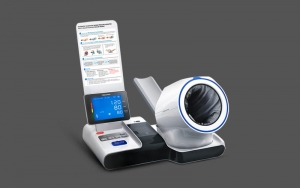
Source:
The best BP apparatus can be divided into two broad categories: Manual and Digital. Each category is further split into different other smaller groups depending on the nature of the BP monitor.
Manual Blood Pressure Monitors
These are sphygmomanometers that need a stethoscope to get readings. They do not have an automatic display screen; instead, the doctor listens to the palpitations through the stethoscope to make any conclusions. For this reason, manual BP monitors can only be used by experienced physicians. Two types of devices fall under this category:
Mercury Sphygmomanometers
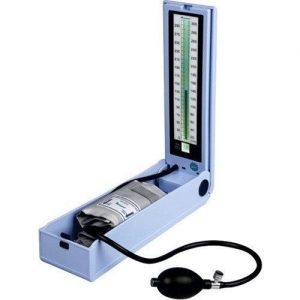
Source: pinterest.com
This device uses a mercury column to indicate the pressure in the blood without any need for recalibration. Their readings are so accurate that they are usually referred to as the gold standards of blood pressure measuring devices in the medical world. Their accuracy comes in handy during clinical trials of drugs and when dealing with high-risk patients like pregnant women.
Aneroid Sphygmomanometers

Source: pixabay.com
These are mechanical types of sphygmomanometers that are the most common. They use a stethoscope for most of their workings, and unlike their mercury counterparts, they need recalibration after every use. However, they are considered to be safer and cheaper than mercury sphygmomanometers, although their accuracy is slightly inferior.
Digital Blood Pressure Monitors

Source: pixabay.com
Digital BP monitors rely on electronic calculations and oscillometric measurements instead of auscultations. They are much easier to operate since most come with single buttons and display screens that show all the measurements. Some even go a step further and incorporate other features like Bluetooth connectivity that allows them to be linked to mobile apps.
PulseWave Blood Pressure Monitors
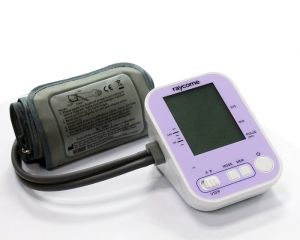
This an innovative technology (not Oscillometric method), using dual-balloons/sensors technology (instead of other single balloons/sensor ordinary digital blood pressure devices) and continuous measurement of multi-point pressure between pulses to achieve the most accurate measurement during the record of the accurate real state of blood flow. It was called the most accurate BP device. A rechargeable Lithium battery saves costs for users. Raycome has the authoritative endorsement and invention patent for PulseWave BP monitor, feel free to contact us to learn more about this BP monitor.
All types of blood pressure monitors that employ the same principle fall under this group. Arm BP monitors, Paediatric BP monitors, and Wrist BP monitors, just to mention a few, all fall under this group.
How to Choose a Blood Pressure Monitor

Source: pinterest.com
When choosing the best BP monitor machine for home use, there are factors that you need to pay attention to. They include the following:
- The Price: When you decide to buy a monitor for measuring blood pressure at home, make sure it is within your budget. It goes without saying that the best and the most accurate BP monitors cost a fortune. However, many other cheaper options in the market work just fine. Look around first and compare prices both online and in physical stores before settling on one.
- Extra Accessories: You have the option of going for the simplest device in the market, the one that comes with a single button for all functions and an elaborate display. At the same time, you can choose to make your work much easier by going for a BP machine that has Bluetooth and Wi-Fi connectivity. These features will allow you to link the devices to mobile apps and cloud storage.
- Accuracy: A good BP monitor should be as accurate as possible; it should be able to operate on the same level as hospital BP machines. An inaccurate device will give the wrong readings making you think you are okay when you are not or sending you into a panic, assuming you are sick when you are okay. A misdiagnosis is as dangerous as the disease itself. Therefore make sure that the device you go for is on the higher side of accuracy.
- Clinical Validation: Everybody feels much safer when they use products that come recommended by professionals. For instance, a hospital-grade blood pressure monitor that has received the mark of approval from most doctors is a better bet than the one that barely registers any attention from anyone. Before buying anything, consult with your doctor first for pointers.
- The Brand: Devices made by established blood pressure monitor manufacturers hold more sway than little known brands—the bigger the brand, the higher the chance that the product in question is top grade. However, you will have to make peace with the possibility of paying a lot more than you would have for a different BP monitor.
- Ease of Use: Compared to a hospital blood pressure machine, a home-use BP monitor should be much simpler both in operation and interpretation of data. The reason why these devices exist in the first place was to make it easier for people to conduct the tests themselves to reduce trips to the hospitals. A good BP monitor should be straightforward when it comes to operating it and understanding the measurement readings.
Factors that can Affect Blood Pressure Readings

Source: pixabay.com
A Full Bladder
Your blood pressure depends on how full or how empty your bladder is. An empty bladder results in lower blood pressure, while a full one leads to higher blood pressure. A full bladder is known to increase systolic pressure by up to 15mmHg. Make sure you are empty before taking measurements.
Temperature
Blood pressure increases when you are cold and decreases when conditions get warmer. If you find the room you are in a bit too chilly, then be aware that any blood pressure measurements you conduct will not reflect the real picture.
Being Too Active
When measuring blood pressure, you are supposed to be calm and rested. Do not move about too much or conduct the test while you are animatedly talking to someone. That is why it is recommended that the test is done while sitting. Too much activity increases the blood flow in the body, and this spikes the blood pressure unnecessarily.
Emotional State
Emotions like anger, anxiety, and stress can cause massive elevations of blood pressure. If you choose to have your pressure taken when you are in a state of agitation, the reading will not reflect the true state of your body’s condition.
Sitting Position
Blood pressure measurements are administered with the subject seated. The chair should be comfortable with the back supported. The legs and arms should be uncrossed so as not to constrict blood flow in some areas as this could spike the overall pressure.
Frequently Asked Questions When using a Blood Pressure Monitor

Source: pixabay.com
The need to know the finer details of blood pressure and everything else that pertains to the procedure is essential. Many people love to run online with their symptoms, frantically searching for answers. The following are some of the most frequently asked questions about blood pressure monitors.
What Causes High Blood Pressure?
Obesity compounded with a lack of exercise and activity is the leading cause of high blood pressure among people these days. Other underlying triggers include genetics, old age, a poor diet, and general poor lifestyle habits like smoking and heavy drinking.
When should I start to get worried?
When using home blood pressure kits, you should immediately rush to the nearest hospital if the blood pressure readings are anywhere near or above 180/120 mmHg. This is what is referred to as the Hypertensive Crisis and is an indicator of a severe health problem waiting to erupt.
What is normal blood pressure?
Blood pressure is considered to be within normal parameters if you register a systolic pressure of 120 or below and a diastolic pressure of 80 and below. For babies, the readings should be in the 60-90/20-60 region.
What are some of the dangers of high blood pressure?
When hypertension is allowed to fester unchecked, you stand a high risk of being struck by a stroke or suffering a severe heart attack that can lead to death. Other risky conditions that are associated with high blood pressure include kidney issues, dementia, aneurysm, and loss of memory, among other issues.
Is high blood pressure treatable?
There are two ways of dealing with high blood pressure. The first one can be achieved through a change in lifestyle. You may have to drop all those habits that contribute to hypertension and embrace regular exercise and a proper diet. The other way is through drugs. Medicines used to treat hypertension include diuretics, ACE inhibitors, calcium channel blockers, among many others.
Conclusion
There is so much information pertaining to hypertension and the use of high blood pressure monitors to keep it in check. The emerging trend right now leans towards the use of BP checking machines at home. As more technologically advanced devices are released into the market, their prices are getting lower. For as little as $20, you can acquire a decent home blood pressure machine that is easily operable.
The bottom line is that your health is important, and it should take precedence ahead of everything else. There is so much that you can achieve in life when you are confident in your health. If you have been considering buying a BP monitor for home use, this is the time.


